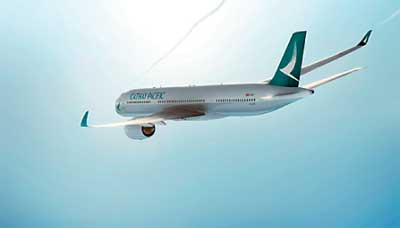Friday Mar 14, 2025
Friday Mar 14, 2025
Tuesday, 15 March 2016 00:01 - - {{hitsCtrl.values.hits}}
The Cathay Pacific Group reported an attributable profit of HK$6,000 million for 2015. This compares to a profit of HK$3,150 million in 2014. Earnings per share were HK152.5 cents compared to HK80.1 cents in the previous year.
The Group’s performance in 2015 was better than in 2014, with the business benefiting from low fuel prices. The high passenger load factors experienced in the first half of the year continued in the second half, reflecting strong economy class demand. 
Premium class demand was not as strong as expected on some long-haul routes. Air cargo demand, which came under pressure during the second quarter of the year, remained weak in the second half. There was an improved contribution from the Group’s subsidiary and associated companies.
The Group’s passenger revenue in 2015 was HK$73,047 million, a decrease of 3.5% compared to 2014. Capacity increased by 5.9%, reflecting the introduction of new routes (to Boston, Düsseldorf, Hiroshima and Zurich) and increased frequencies on some other routes. The load factor increased by 2.4 percentage points, to 85.7%.
Strong competition, a significant reduction in fuel surcharges, unfavourable foreign currency movements and the fact that a higher proportion of passengers were connecting through Hong Kong put downward pressure on yield, which decreased by 11.4% to HK59.6 cents. Economy class demand was strong. Premium class demand improved on regional routes but was not as strong as expected on some long-haul routes.
The Group’s cargo revenue in 2015 was HK$23,122 million, a decrease of 9.0% compared to the previous year. This mainly reflected a reduction in fuel surcharges due to lower fuel prices. Capacity for Cathay Pacific and Dragonair increased by 5.4%. The load factor decreased by 0.1 percentage points to 64.2%.
Strong competition, overcapacity, unfavourable foreign currency movements and the reduction in fuel surcharges put pressure on yield, which decreased by 13.2%, to HK$1.90. Demand was strong in the first quarter of 2015, assisted by industrial action at ports on the west coast of the United States. Overall demand was weak for the rest of the year, particularly on European routes.
Discover Kapruka, the leading online shopping platform in Sri Lanka, where you can conveniently send Gifts and Flowers to your loved ones for any event including Valentine ’s Day. Explore a wide range of popular Shopping Categories on Kapruka, including Toys, Groceries, Electronics, Birthday Cakes, Fruits, Chocolates, Flower Bouquets, Clothing, Watches, Lingerie, Gift Sets and Jewellery. Also if you’re interested in selling with Kapruka, Partner Central by Kapruka is the best solution to start with. Moreover, through Kapruka Global Shop, you can also enjoy the convenience of purchasing products from renowned platforms like Amazon and eBay and have them delivered to Sri Lanka.
Discover Kapruka, the leading online shopping platform in Sri Lanka, where you can conveniently send Gifts and Flowers to your loved ones for any event including Valentine ’s Day. Explore a wide range of popular Shopping Categories on Kapruka, including Toys, Groceries, Electronics, Birthday Cakes, Fruits, Chocolates, Flower Bouquets, Clothing, Watches, Lingerie, Gift Sets and Jewellery. Also if you’re interested in selling with Kapruka, Partner Central by Kapruka is the best solution to start with. Moreover, through Kapruka Global Shop, you can also enjoy the convenience of purchasing products from renowned platforms like Amazon and eBay and have them delivered to Sri Lanka.